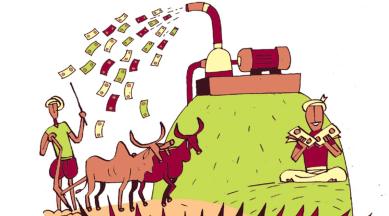Aanchal Magazine is Senior Assistant Editor with The Indian Express and reports on the macro economy and fiscal policy, with a special focus on economic science, labour trends, taxation and revenue metrics. With over 13 years of newsroom experience, she has also reported in detail on macroeconomic data such as trends and policy actions related to inflation, GDP growth and fiscal arithmetic. Interested in the history of her homeland, Kashmir, she likes to read about its culture and tradition in her spare time, along with trying to map the journeys of displacement from there. ... Read More
Premium
Union Budget 2018, Macro: Despite farm push, govt spending slowest in three pre-poll years
Union Budget 2018: Growth rate of govt expenditure in 2018-19 is also lower than the 12.3% seen in spending in 2017-18 over the actual spending of preceding fiscal.

The spike in rural allocation notwithstanding, the increase of 10.1 per cent in government spending in the Budget Estimate of 2018-19 over the current year’s revised estimate marks the slowest rate of expenditure growth in each of the last three pre-election years. The growth rate of government expenditure in 2018-19 is also lower than the 12.3 per cent growth seen in spending in 2017-18 over the actual spending of preceding financial year, a sign that the government has refrained from loosening its purse strings to the extent resorted to by governments in an election year.
In the previous pre-election year of 2013-14, the government expenditure had grown by 10.6 per cent to 15.59 lakh crore, while in 2008-09, the year before election year 2009, government spending had grown by 24 per cent to 8.83 lakh crore. The years before and after the 2009 elections were an aberration with a higher rate of increase in government expenditure due to the farmers’ debt relief scheme and a stimulus package, respectively. Even in the pre-election year of 2003-04, the government expenditure had recorded a growth of 13.8 per cent over the preceding fiscal.
You have exhausted your
monthly limit of free stories.
monthly limit of free stories.
Read more stories for free
with an Express account.
with an Express account.
Already have an account? Sign In
Read this and every other premium story with a digital subscription.
Already a subscriber? Sign In
Read this and every other premium story with a digital subscription.
This content is exclusive for our subscribers.
Subscribe now to get unlimited access to The Indian Express exclusive and premium stories.
Already a subscriber? Sign In
Read | Breaking down the Budget in 20 questions
For 2018-19, the Budget Estimate for total expenditure of the Centre is pegged at Rs 24.42 lakh crore with an increase of Rs 2.24 lakh crore or 10.1 per cent over the revised estimates of 2017-18. The accompanying documents to the Union Budget 2018-19 stated that as a percentage of GDP, the total expenditure of the government is estimated to taper down to 13 per cent of GDP in 2018-19 and are anticipated to taper further over the medium term to 12.7 per cent of GDP each in 2019-20 and 2020-21.
The total expenditure as a percentage of GDP had declined from the high of 15.8 per cent of GDP in 2009-10 to 13.2 per cent of GDP in revised estimates of 2017-18, it said. Capital expenditure in 2018-19 is estimated to be around Rs 3 lakh crore, constituting 12.3 per cent of the total expenditure estimated for the year. In the medium term the share of capital expenditure in total expenditure is projected to increase to 12.6 per cent in 2019-20 and 12.9 per cent in 2020-21, the Budget documents stated.
“However, for a holistic perspective of the Central Government expenditure of capital nature, it would be useful to review the status of the Internal and Extra Budgetary Resources (IEBR) estimated to be deployed by the Central Government public sector enterprises and the commercial departmental undertakings,” it added. In 2018-19, the total IEBR is estimated at Rs 4.78 lakh crore, slightly higher than Rs 4.76 lakh crore estimated in the revised estimates for 2017-18.
Also read | Rural poor is focus, cost is breach of fiscal target
The capital expenditure reduced by 4.5 per cent to Rs 2.73 lakh crore in from Rs 2.86 lakh crore in 2016-17 (actuals). In 2017-18, the capital expenditure was 12.3 per cent of the total expenditure.
Story continues below this ad
Revenue expenditure, the second component of total expenditure, is estimated at Rs 21.41 lakh crore. Interest payments constitute the largest component of Centre’s revenue expenditure. However, in 2018-19, the ratio of interest payments to the total revenue receipts of the centre is anticipated to decline to 33.4 per cent. In the revised estimates of 2017-18, interest payments are estimated to be Rs 5.31 lakh crore , with the ratio of interest payments to the total revenue receipts expected to be 35.3 per cent. The interest payments projections in the medium term are expected to be benign, partly because of the successful inflation management by the RBI, the Budget said.
The total interest payments outgo as a percentage of total revenue receipts is expected to 31.6 per cent in 2019-20 and 29.8 per cent in 2020-21. However, the impact of any increase in petroleum and other oil prices on the inflation situation in the country pose as the main risks to the projections, it said.
The expenditure on ‘Major subsidies on Food, Fertilizer and Petroleum’ is the second most significant component of revenue expenditure. In 2018-19, major subsidies have been estimated at Rs 2.64 lakh crore, an increase of Rs 34,620 crore over the revised estimates for 2017-18. However, in the medium term this figure is estimated to taper to 1.3 per cent and 1.2 per cent in 2019-20 and 2020-21 respectively, it said.
Tags: